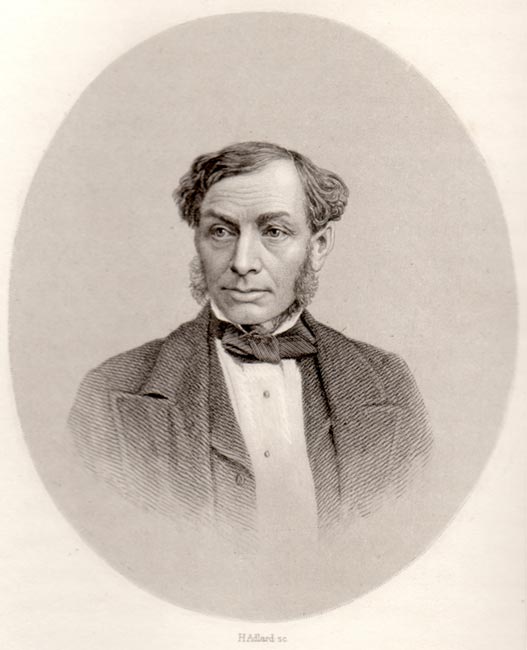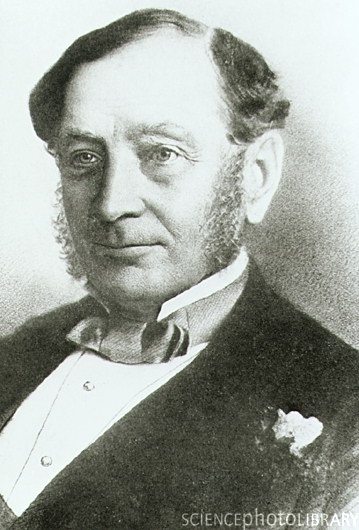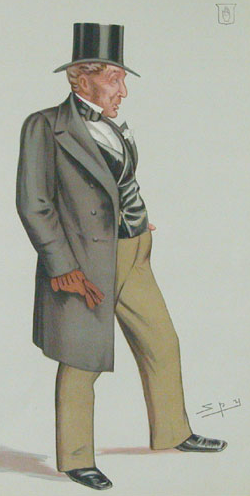<Back to Index>
- Engineer Daniel Gooch, 1816
- Poet Robert Herrick, 1591
- 1st President of Sierra Leone Siaka Probyn Stevens, 1905
PAGE SPONSOR



Sir Daniel Gooch, 1st Baronet (24 August 1816 – 15 October 1889) was an English railway and transatlantic cable engineer and Conservative politician who sat in the House of Commons from 1865 to 1885. He was the first Superintendent of Locomotive Engines on the Great Western Railway from 1837 to 1864 and its Chairman from 1865 to 1889.
Gooch was born in Bedlington, Northumberland, the son of John Gooch, an ironfounder, and his wife Anna Longridge. He trained in engineering with a variety of companies, including a period with Robert Stephenson and Company, but was aged 21 when recruited by Isambard Kingdom Brunel for the Great Western Railway, under the title "Superintendent of Locomotive Engines", taking office on 18 August 1837.
Gooch's earliest days with the company were a struggle to keep the miscellaneous collection of 7 ft ¼ in (2,140 mm) broad gauge steam locomotives ordered by Brunel working. Taking the best of these, the GWR Star Class (on which he and Brunel had improved the blast pipe arrangement) as a model, he designed the GWR Firefly Class of 2-2-2 express passenger locomotives introduced in 1840. In comparative trials by the Gauge Commissioners, Ixion of this class proved capable of speeds greater than its standard gauge challenger. In 1843 Gooch introduced a new form of locomotive valve gear.
In 1840, Gooch was responsible for identifying the site of Swindon Works and in 1846 for designing the first complete locomotive to be constructed there, Great Western, prototype of the GWR Iron Duke Class of 4-2-2s which were able to achieve 70 miles per hour (110 km/h)
and which, much renewed, saw out the broad gauge. Though Gooch's
locomotives were principally for the broad gauge, between 1854 and 1864
he also had to design a number of standard gauge classes for
the GWR's new Northern Division.
In 1864 Gooch resigned from his post
of Locomotive Superintendent, though he continued as a member of the
GWR Board.
From 1859 Gooch lived at Clewer Park in Windsor and was a Deputy Lieutenant for Berkshire. In
1865, Gooch was recalled to the Great Western Railway Company as
Chairman. He was also chief engineer of the Telegraph Construction
Company. In this role, he was also instrumental in laying the first
successful Transatlantic telegraph cable, using the SS Great Eastern (1865/66).
In 1865, while out of the country laying the cable, Gooch was elected Conservative MP for Cricklade. He held the seat until 1885.
In 1866 Gooch was created a Baronet in recognition of his cable work. In 1868 he became chairman of the Telegraph Construction Company after John Pender the first chairman resigned. He led the Great Western Railway out of near-bankruptcy and took a particular interest in construction of the Severn Tunnel. Final abandonment of the broad gauge did not take place until after his death at the age of 73.
Gooch married Margaret Tanner in 1838. Following her death in 1868 he married Emily Burder in 1870; she died in 1901. His brothers John Viret Gooch, Thomas Longridge Gooch and William Frederick Gooch were also railway engineers.